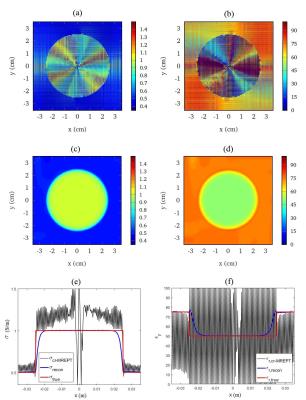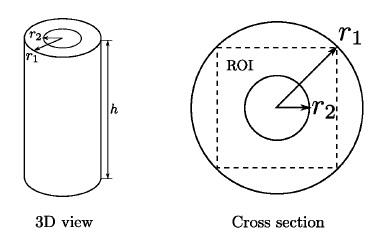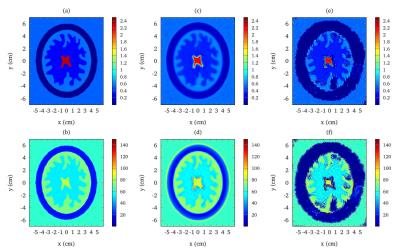1947
A stabilized convection-reaction magnetic resonance electrical property tomography (crMREPT) using viscosity-type regularization1Singapore University of Technology and Design, Singapore, Singapore, 2Center for Frontier Medical Engineering, Chiba University, Japan, 3Department of Surgery, National University of Singapore, Singapore
Synopsis
Convection-reaction MREPT (crMREPT) method is a more general approach to reconstruct an electrical property map based on B1-maps from a magnetic resonance imaging (MRI) scanner compared to other existing methods in the literature, such as electrical property tomography (EPT) and local Maxwell tomography (LMT). However, crMREPT shows global spurious oscillations in the reconstructed maps and persistent artifacts in the region when $$$\small\triangledown|B_1|$$$ is small. We propose a solution to effectively mitigate the artifacts by applying a viscosity-type regularization. This abstract shows that the proposed method significantly increases the accuracy of the reconstructed electrical property maps and reduces the sensitivity to noise comparing to crMREPT.
Purpose
Knowledge of the spatial distribution of electrical properties (an electrical property map) namely permittivity, ε and conductivity, σ, is valuable to various diagnostic and therapeutic technologies and for in vivo specific absorption rate (SAR) mapping in ultra-high-field magnetic resonance imaging (MRI). Magnetic resonance electrical property tomography (MREPT) produces an electrical property map based on B1-maps only. Well-known MREPT methods are electric property tomography (EPT)1-2 that solves the Maxwell’s equations directly, the local Maxwell tomography (LMT)3 that solves an $$$\small Ax = b$$$ system based on Maxwell’s equations and data from a scanner with multiple channels are needed, and the convection-reaction MREPT method (crMREPT) which numerically solves a partial differential equation (PDE) derived from Maxwell’s equations4. crMREPT is more general than EPT1-2 and has simpler form than LMT. However, it shows global spurious oscillations in the reconstructed maps and persistent artifacts in the region when $$$\small\triangledown|B_1|$$$ is small5-6. We propose a solution to effectively mitigate the artifacts by applying a viscosity-type regularization7. The proposed method significantly increases the accuracy of the reconstructed electrical property maps and reduces the sensitivity to noise.Method
The crMREPT calculates ε and σ by solving the following equation $$$\small\it\left(L+M\right)\cdot\triangledown\gamma-\gamma\triangledown^2H_1^++i\omega\mu H_1^+=0$$$ (1), where $$$\small\gamma=\frac{1}{\sigma+i\omega\epsilon}$$$, $$$\scriptsize H_1^+=\frac{H_x+iH_y}{2}$$$, $$$\scriptsize\it L =\left[-\frac{\partial H_1^+}{\partial x}+i\frac{\partial H_1^+}{\partial y}, -i\frac{\partial H_1^+}{\partial x}-\frac{\partial H_1^+}{\partial y},-\frac{\partial H_1^+}{\partial z}\right]$$$, $$$\scriptsize\it M = \left[-\frac{1}{2}\frac{\partial H_z}{\partial z}, -\frac{i}{2}\frac{\partial H_z}{\partial z}, \frac{i}{2}\frac{\partial H_z}{\partial y}+\frac{1}{2}\frac{\partial H_z}{\partial x}\right]$$$. For a 2D case and when Hz is negligible (e.g. at the center of a birdcage coil) and the spatial variations of Hz are negligible ($$$\small\it M \approx 0$$$), (1) becomes $$$\small\it L_{xy}\cdot\triangledown_{xy}\gamma-\gamma\triangledown^2H_1^++i\omega\mu H_1^+=0$$$ (2), where $$$\scriptsize L_{xy}=\left[-\frac{\partial H_1^+}{\partial x}+i\frac{\partial H_1^+}{\partial y},-i\frac{\partial H_1^+}{\partial x}-\frac{\partial H_1^+}{\partial y}\right]$$$. By applying (2), Fig. 1 (a) and (b) show the reconstructed σ - and εr - maps of the region of interest (ROI) of a double-layered cylinder as shown in Fig. 2, respectively. Birdcage coil is used and the working frequency is 128MHz. As shown in Fig. 1 (a) and (b), severe artifacts and oscillations are populated in the maps. Equation (2) is a convection-reaction PDE (crPDE) with complex coefficients. Unlike the crPDE’s with real coefficients, the artifacts of crMREPT cannot be mitigated by increasing the discretization density nor by applying minimization method (avoiding $$$\small\triangledown^2H_1^+\approx0 $$$ or $$$\small H_1^+\approx0$$$). The reason lies in the fact that $$$\small\triangledown^2H_1^+$$$ is not smooth at the boundary where electrical properties are discontinuous in the ROI. Following are the further explanations. If (2) is expressed as $$$\small\overline{F}(\overline{r})\cdot\triangledown_{xy}\gamma=f(\overline{r},\gamma(\overline{r}))$$$ where $$$\small\overline{F}(\overline{r})=\it L_{xy}$$$ and $$$\small f(\overline{r},\gamma(\overline{r}))=\gamma\triangledown^2H_1^+-i\omega\mu H_1^+$$$, the unsmooth $$$\small\triangledown^2H_1^+$$$ in the ROI leads to unanalytic $$$\small f(\overline{r},\gamma(\overline{r}))$$$. According to Cauchy-Kowalevski theorem8, unanalytic $$$\small f(\overline{r},\gamma(\overline{r}))$$$ causes unsmooth solutions of (2). To tackle this problem, we propose to apply a viscosity-type regularization7 by adding a stabilization term $$$\small\rho\triangledown^2\gamma$$$ to (1) or $$$\small\rho\triangledown_{xy}^2\gamma$$$ to (2) for 2D cases. Equation (2) becomes $$$\small\rho\triangledown^2_{xy}\gamma+\it L_{xy}\cdot\triangledown_{xy}\gamma-\gamma\triangledown^2H_1^++i\omega\mu H_1^+=0$$$ (3), where $$$\small\rho$$$ is the stabilization constant, $$$\small 0<\rho<1$$$. Finite difference is used for discretization.
Results
Fig. 1 (c) and (d) show the reconstructed σ - and εr - maps of the double-layered cylinder (Fig. 2) by applying the proposed method, respectively. The same coil and frequency are used, $$$\rho$$$ is set to be 0.37. Fig. 1 (e) and (f) show the reconstructed σ and εr along y = 0, respectively. Moreover, the data for a simplified human head phantom are used to test the accuracy and noise sensitivity of the method. Fig.3 shows the true maps ((a) (b)), those reconstructed by applying the proposed stabilized crMREPT ((c) (d)), and those by applying crMREPT4 ((e) (f)). The noise level (complex white Gaussian noise) is 60 dB.
Discussions
As can be seen in Fig. 1 (c) and (d), the persistent artifacts appear in the solution of crMREPT (Fig. 1 (a), (b)) are effectively mitigated by the proposed stabilization method. This mitigation can be clearly seen in the data along the x-axis (y = 0), as shown in Fig. 1 (e) and (f). For the maps for a simplified head phantom shown in Fig. 3, at the same noise level, the maps by applying the stabilized crMREPT show a normalized root-mean-square-error (NRMSE) of 15% which indicates much higher accuracy compared to those without stabilization.Conclusion
An effective stabilization method, the viscosity-type regularization, has been successfully applied to mitigate the artifacts of the electrical property maps reconstructed by applying the crMREPT method. It has been shown in 2D cases that the mitigations are effective and the sensitivity to noise is lower compared to the conventional crMREPT. The method will be extended to 3D and applied to measured data to show its practical values.Acknowledgements
No acknowledgement found.References
1. Katscher U, Voigt T, Findeklee C, Vernickel P, et al. Determination of Electric Conductivity and Local SAR Via B1 Mapping. Med. Imaging IEEE Trans. 2009 Sep.28(9):1365–1374.
2. Voigt T, Katscher U, Doessel O. Quantitative conductivity and permittivity imaging of the human brain using electric properties tomography. Magn. Reson. Med. 2011;66(2):456–466.
3. D. K. Sodickson Alon L, Deniz C, et al. Local Maxwell tomography using transmit-receive coil arrays for contact-free mapping of tissue electrical properties and determination of absolute RF phase. ISMRM 2012, 387.
4. Song Y, and Seo J. Conductivity and permittivity image reconstruction at the Larmor frequency using MRI. SIAM J. Appl. Math. 2013; 73(6): 2262-2280.
5. Ammari H, Kwon H, Lee Y, et al. Magnetic resonance-based reconstruction method of conductivity and permittivity distributions at the Larmor frequency. Inverse Problems 2015; 31(10): 105001-105024.
6. Hafalir F, Oran O, Gurler N, et al. Convection-reaction equation based magnetic resonance electrical properties tomography (cr-MREPT). IEEE Trans. Med. Imag. 2014; 33(3): 777-793.
7. Ammari H, Grasland-Mongrain P, Millien P, et al. A mathematical and numerical framework for ultrasonically-induced lorentz force electrical impedance tomography. Journal de Mathmatiques Pures et Appliques 2015; 103(6): 1390 - 1409.
8. Kowalevsky S. Zur theorie der partiellen differentialgleichung. J. Reine Angew. Math. 1875; 80: 1-32.
Figures


